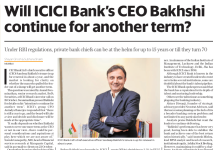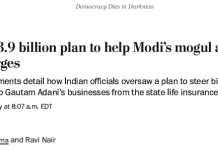Updated: 27 Jun 2021, 10:13 PM IST Gopika Gopakumar, Shayan
Ghosh
Sandeep Bakhshi took over an embattled bank in late 2018. In just 10
quarters, things have changed
Since Bakhshi joined, the share of the bank’s corporate loans in the
total loan book has been almost flat at 24%. Moreover, the bank now
has 73.2% of its loans to customers rated ‘A-’ and above
MUMBAI: Employees clocking in early on a muggy November 2018
morning to get into the comfort of ICICI Bank’s air-conditioned
headquarters in the central Bandra Kurla Complex spotted someone
unusual among them in the elevator queues.
It was Sandeep Bakhshi, the new managing director and chief executive
officer who had slipped into those shoes just a few weeks earlier. Like any
other legacy institution in India, ICICI Bank Towers has separate
elevators for regular employees and directors. Bakhshi, too, had access to
an exclusive elevator that could whisk him away to his 10th floor office.
But he was waiting in the queue meant for all bank employees.
The new CEO was signalling a powerful culture change at India’s second
largest private bank by assets. “I was pleasantly surprised at his humility,
or at least the intent to be seen as a regular employee,” said an employee
who stood in the elevator queue that morning. “I have not seen any former
boss do that.”Bakhshi continues to use the common elevator to date.
It has been 10 quarters since Bakhshi was brought in to steady the ship
after the bank had been buffeted by allegations that the previous managing
director and CEO, Chanda Kochhar, had favoured the Videocon Group.
She had resigned on 4 October 2018 and on the same day Bakhshi, then
chief operating officer at the bank, was appointed as the top boss.

Within a short span, he has attempted a slew of changes, some of which
will yield results only in the long run at the 27-year-old lender. The bank
has renewed its focus on better quality assets, shedding its earlier singleminded attention to growth. Branch-level managers now have greater leeway to decide targets that best suit their context. There is also a renewed push into retail banking spearheaded by digital operations. The
common thread connecting the disparate changes: A focus on the bank’s
culture and an effort to get rid of ‘short-termism’.
Bakhshi was not available to be interviewed for this story, but it doesn’t
seem to worry him much that arch rival HDFC Bank, India’s no. 2 lender,
keeps the position in the leader board that it had wrested from ICICI Bank
in 2017 (India’s top bank by assets is the government-owned State Bank
of India).
“The new CEO believes that we should only sell products to customers
which we think we could sell to our family,” said the employee quoted
above.
Bakhshi, who has clocked 35 years at the ICICI group of companies, has
fought corporate fires before. In 2010, he was brought in to lead ICICI
Prudential Life to manage an internal crisis. He had inherited an
aggressive sales-at-any-cost culture set in place by the firm’s first chief
executive Shikha Sharma, who was immensely successful during her
time. Mis-selling was rampant in the insurance industry, especially in the
equity-linked product segment. Bakhshi turned around ICICI Pru, as it is
known in the industry, by shrinking its set of products and eventually took
the company public. What he delivered made him the shoo-in candidate
to restore the credibility of ICICI Bank and he was inducted as the chief
operating officer in August 2018, two months before Kochhar quit. Then,
he became the CEO.
A new narrative
Embattled troops need hope the most and like any leader stepping into a
bad situation, Bakhshi crafted a new narrative: “One bank, One RoE, one
KPI” (RoE being short for return on equity and KPI for key performance
indicator). He removed several performance indicators that were
associated with multiple products at the branch level.
Experts credit this one tagline for improved efficiency at the bank, as it
removed the burden of monthly sales targets on several products. Insiders
say that there used to be as many as 14 different KPIs at the branch level,
making work distracting and difficult for employees. Some of these
targets were related to fixed deposits, current and savings accounts, and
mutual funds, among others.
The bank woke up to the need for KPIs at the branch level, depending on
the location and local demographic profile. For instance, a branch in a
locality of retirees would not need credit cards or small business loan
targets. Instead, the staff must woo depositors and maintain a strong
inflow of term deposits.
On the lending side, ICICI Bank’s new strategy shows the risk profile of
its corporate assets. Since Bakhshi joined, the share of the bank’s
corporate loans in the total loan book has been almost flat at 24%. And
asset quality? The bank now has 73.2% of its loans to customers rated ‘A-
’ and above, up from 62.5% as on 31 March 2018, thereby clocking more
than 1.5 times growth in that cohort of customers with lower risk profiles.
The bank’s gross bad loans as a percentage of total loans was 4.96% at
the end of fiscal 2021, down from 7.75% on 31 December 2018, the
quarter when Bakhshi took charge.
In the lending business, riskier bets allow lenders to charge more than
high-rated corporates, who tend to bargain hard for cheaper loans. In other
words, there will inevitably be pressure on margins at ICICI Bank. To
circumvent this, Bakhshi had the bank take a 360-degree approach to
cover all business verticals as a whole and not operate in silos.
What this meant was more teamwork and an attempt to recoup lost
margins in the corporate loans business through volumes in other
segments.
“It was like taking the entire bank to a customer. Even when ICICI Bank
executives now go to a corporate (house), besides giving a term loan, it is
also about getting his transaction banking account, financing his dealers,
vendors and their employees,” said a person aware of the changes.
Retail banking executives pass on opportunities to the corporate team, for
instance. “This is because everybody is looking at achieving the target as
a whole bank,” said the person quoted above.
A third person, who also spoke on condition of anonymity, said that after
the introduction of the new norms, the leadership team of about 400
people get the same bonus, irrespective of the performance of their
verticals. “The idea is to win as a team or lose as a team.”
By removing multiple KPIs, the management also gave flexibility to the
bank branch manager to decide what business worked best for the branch.
Instead of targets that were set top-down from the corporate office, the
manager can decide targets within the guardrails of risk. “The manager
(now) has to decide how to meet the profit target by selling the right
products,” says a former employee of the bank.
The intent was clear—improve operating profit and grow the business
through a risk-calibrated approach.
Stay with the product
The other significant change that Bakhshi brought was to put in place a
sales culture that dislikes customer churn. He had learnt from his ICICI
Pru days that unless the customer stays with a product, the firm cannot see
sustainable profits. At the bank, his motto read: Be fair to the customer,
fair to the bank.
The bank, thus, stopped selling products that were not seen to be
beneficial to customers. As head of the ICICI Prudential Life, Bakhshi
had witnessed rampant mis-selling of products. At ICICI Bank, he
stopped the sale of participating insurance products from ICICI Pru.
Participating products allow the insured customer to receive dividends
from the profits of the insurance company.
This hit the revenue of the ICICI insurer as 60-70% of its business was
dependent on distribution through the bank. The bank also suffered in
terms of loss of fee income. But this was absorbed by the bank’s focus on
selling multiple products to a single customer. The bank’s return on assets
improved from 0.39% at the end of fiscal 2019 to 1.42% by end of fiscal
2021.
ICICI Bank, once at the forefront of corporate banking, has also pivoted
majorly towards the retail segment. The share of retail loans to total
advances has moved from 59% in the December quarter of fiscal 2019
(when Bakhshi joined) to 66.7% in the January-March quarter this year.
In the same period, the bank’s current and savings account deposits, also
called Casa deposits, have grown 44% to ₹4.31 trillion.
While the bank made its digital strides early, it has, of late, started
harnessing the power of data. According to the second person quoted
earlier, over the last three-four years, big, public data meshed with the
bank’s own data has worked well for ICICI Bank. “There are several
customers who keep their digital footprints with the bank and the bank
can therefore align its offerings accordingly. These footprints have
exponentially grown and any bank or financial institution which is able to
use that data and execute on it will be a winner,” said the person
mentioned above.
The bank took another bold decision in December last year when it opened
its mobile banking platform iMobile Pay to customers of other banks.
“Come, try out our offering” was the offer. Over two million sign-ups
from other banks were recorded and many among them opened savings
accounts and applied for credit cards, home loans, and personal loans, the
bank said this June.
All credit to Bakhshi?
How much of the new spring in the steps of ICICI Bank is Bakhshi’s
doing? For all of the credit for turning around the bank, the CEO has
avoided the limelight—a stark difference from his predecessor Kochhar’s
high profile presence in the media and industry bodies. Bakhshi, a
mechanical engineering graduate from Chandigarh, stays the reticent
banker he is.
“Bakhshi seems to be different from former heads of the bank and is more
focused on the job at hand,” said Hemindra Hazari, an independent
commentator.
Others say it’s too early to judge Bakhshi on the basis of his performance
over the last three years. For example, they point out that the economy
was slowing even before the outbreak of the covid-19 pandemic and this
necessitated a pull back on corporate loans.
Inherited momentum helped Bakhshi, too. “He happened to be at the right
place at the right time. The bank had undergone a lot of improvement
under Kochhar’s tenure itself. He, therefore, managed to get a much
cleaner book with a strong retail franchise,” said an analyst, adding that
consistency in the operating numbers for another two years is key.
The recovery in the quarters ahead in the aftermath of the economic ruin
caused by covid-19 will decide much of ICICI Bank’s trajectory under
Bakhshi. For instance, an analyst at a rating agency said, “Our concerns
remain on the quality of retail assets over a period of time as the growth
has been substantial.”
A hit on the salaries of consumer loan borrowers could directly impact the
bank’s retail portfolio. For now, the markets seem sanguine about ICICI
Bank and Bakhshi. Shares of ICICI Bank have more than doubled to reach
levels of ₹640-650 in the week gone by, as compared to where they stood
when Bakhshi took over as the CEO. This compares to a 57% increase in
the BSE Sensex, the Bombay Stock Exchange’s benchmark index, and
40% increase in BSE Bankex.
It reflects confidence in the ICICI Bank stock—a confidence pinned on
the bank’s turnaround of operations and perhaps a turnaround scripted by
Bakhshi.














